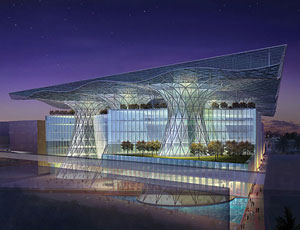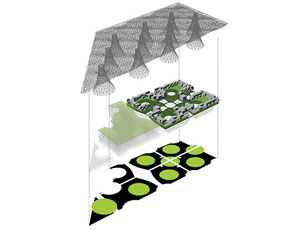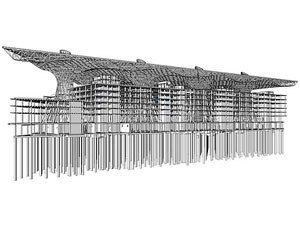It’s a tired, old story and the bane of many a design team: Win an international design competition and then watch helplessly as all the brilliant concepts get whittled away by the developer and its “value engineers” until the constructed building bares little resemblance to the original submission.
It’s a brand new story, and both the delight and challenge of the Chicago-based design team that beat out 158 others to design the 116,372-sq-meter headquarters for the Masdar Initiative in Abu Dhabi—billed as the world’s largest carbon- and waste-neutral office building. In a giant exception to the rule, the client is holding Adrian Smith + Gordon Gill Architecture (AS+GG) and its primary engineers, Thornton Tomasetti (TT) and Environmental Systems Design Inc. (ESD), to their competition promise of delivering not just a sustainable building but a 3% “net-positive-energy” building, as if the promise were a sacred vow.
To keep its own team and the design team hyped on its positively energetic design, the Masdar Initiative reconvened its 12-person competition jury for a formal review about halfway through design. “I’ve never had that experience,” says Gordon Gill, a partner of AS+GG. “It was extremely helpful and a part of probably one of the most mutually collaborative processes” he has ever been involved with, he adds.
As many as 40 people—including Masdar’s team—attended the review, held Nov. 19-21, 2008, at AS+GG. The sessions provided assurances that neither the client nor the design team was straying from the goal of sustainability, says Gill. Robert Sinn, a principal in the Chicago office of structural designer TT, calls the review an “eye-opener,” describing it as a couple of days of “not-so-easy conversations, with Gordon always on the hot seat.”
Juror Dennis A. Andrejko, a professor of architecture at the University at Buffalo, Buffalo, N.Y., calls the design review “really exciting” because of the intention to make the project a showcase for sustainability. “I think this post mortem to recap how the design process was evolving was a great thing,” he says, adding that he had never before heard of such a process. There were “good, solid and comprehensive discussions” about putting back some elements that were a bit problematical, rather than taking a more expedient approach and leaving them out, he adds.
Discussions got down to the nitty-gritty. The group even questioned whether escalators or stairs alone would take people down to the transit tunnels. The decision: provide both. The group also debated whether to plant indigenous desert landscaping or fruit trees in the office building’s shaded roof gardens. The decision: orange trees, because the micro climate being created for the building’s passive solar system would support their growth and the gardens could then easily offer something rare and special in the desert, says Gill.
Masdar City
Piling and grade beam work is finished, and the slab on grade is half complete for the headquarters, which is part of a 6-sq-kilometer development called Masdar City (http://masdarcity.com/en/index.aspx). The estimated $22-billion mini city is an initiative of the emirate-owned Abu Dhabi Future Energy Co. The Masdar City master plan by Foster & Partners, expected to be built out by 2016, describes a sustainable development laid out as a high-density, auto-free city with mixed uses. Masdar Headquarters, which will house about 2,500 people, including about 200 from the International Renewable Energy Agency, is scheduled to be completed in 2012. “We have a budget for the headquarters but while the negotiation for the contractors is still pending, we do not want to publicize the cost as it has commercial implications,” says a Masdar spokesman.
When asked whether the current financial crisis in neighboring emirate Dubai will have any effect on the Masdar project, the spokesman says, “We are not prepared to talk about Dubai and the impact but it doesn’t have any impact for Masdar Headquarters so far.” The general construction contract is expected to be let early next year.
Sustainable
As designed, the headquarters would yield zero carbon emissions and zero liquid and solid waste. The strategy is to reduce energy consumption through passive solar and efficient systems to a level that can be sustained through on-site energy production. A rooftop photovoltaic (PV) system is expected to produce 3.5 MW of electricity each year by harvesting the desert site’s abundant sunlight. It will supply 100% of the building’s total energy, and building-integrated PV panels will provide a 2% surplus. In principle, “The building is either protecting itself from the sun’s heat or harvesting solar energy,” says Gill.
Though sources say sustainability adds an initial first cost, Masdar officials say the premium will not be known until the building’s final cost is known. “We hope to make green building competitive with conventional building eventually,” says the spokesman.
Headquarters plans call for a rather mundane seven-story, concrete-framed office building that by itself would not...





Post a comment to this article
Report Abusive Comment